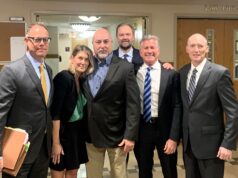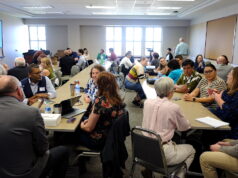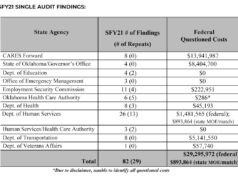
As COVID-19 continues to upend American life and receive a necessary but sometimes overwhelming amount of news coverage, it can be tough to keep track of all the storylines.
Below is a reminder of key COVID-19 tracking resources, as well as a few stories from local and national outlets that you may have missed.
Know where to find data
On April 10, the Oklahoma State Department of Health released its latest COVID-19 modeling that predicts the virus’ potential spread. The projections span April 8 through May 1 and provide estimates of an April 21 peak that would feature 436 new cases identified and 22 deaths that day. The projections for May 1 include Oklahoma’s cumulative cases reaching 9,300 and cumulative deaths reaching 469.
The window In addition, the following sites can be used to keep tabs on broader COVID-19 numbers:
- The Johns Hopkins Coronavirus Resource Center;
- The World Health Organization’s map.
- The Oklahoma State Department of Health’s tracking page;
- And each weekday, the OSDH also releases deeper reports, which now contain information on nursing home diagnoses, race and ethnicity data and the state’s access to personal protective equipment;
Stories you may have missed
The following pieces may have skipped past you in recent days. Click each headline’s link to read the full story from the original publication.
The Oklahoman: Six COVID-19 cases linked to Oklahoma County party
Several affluent Oklahomans appear to have been exposed to the novel coronavirus at a Feb. 27 party, about two weeks before the first COVID-19 cases were diagnosed in Oklahoma.
The party, held at an Oklahoma City country club, has been connected to at least six cases and one fatality, according to The Oklahoman.
The Oklahoman: INTEGRIS temporarily closing down Portland Avenue site; ER to stay open
Every action has a reaction. Attempts to preserve personal protective equipment, medications and other resources by a statewide mandatory postponement of elective and non-elective surgeries have caused hospitals in the state to lose substantial revenue.
In Oklahoma City, INTEGRIS Health is shuttering its Portland Avenue location — formerly Deaconess Hospital — for an indefinite amount of time.
“The direct personal caregivers are being reassigned to the Baptist campus,” Cayot said. “It’s the non-direct patient care employees, for the most part, who will be considered for furlough just like all the other caregivers in our system right now,” INTEGRIS spokeswoman Brooke Cayot told The Oklahoman.
Daily Wire: Emergency medicine doc talks COVID-19, how it’s different than the flu, and what he’s seeing on the ground
Dr. Zachary Blankenship, DO, is a fourth-year doctor of emergency medicine resident in New York City, and last week he spoke with The Daily Wire about what he is seeing on the frontlines fighting the COVID-19 pandemic.
In the Q&A piece — which also dives into the weeds of patient care — Blankenship notes that he hails from Oklahoma and has a message for his home-state friends.
“My family back in Oklahoma, and my friends in Oklahoma, they just don’t get it,” Blankenship said, explaining why he released a video of himself explaining his work experience on social media. “I think that, I don’t know, maybe the news somehow isn’t real enough to people. So maybe if they see my face and hear my voice, then maybe it’ll become real for them.”
Tulsa World: Stitt commutes sentences for more than 450 offenders to ease crowding, reduce COVID-19 risk
On Friday, April 10, Gov. Kevin Stitt announced that he had approved commutations for 452 inmates in Oklahoma prisons in response to COVID-19.
The move came after a number of advocacy organizations encouraged the governor to reduce prison crowding to reduce the risk of an outbreak and after an inmate at a facility in McAlester tested positive for the virus.
Kris Steele, director for Oklahomans for Criminal Justice Reform, said, “Our state’s prison population, our correctional staff and our rural hospitals are especially vulnerable during this health crisis. I applaud the governor’s leadership and his actions. I truly believe the actions taken today will save lives, reconnect families and ultimately make our state a safer place.”
The Frontier: As unemployment continues record rise, state works to fix claim system unprepared for surge
Over the past month, more than 120,000 new claims for unemployment benefits have been filed with the Oklahoma Employment Security Commission. The state agency was already involved in efforts to modernize its online processes, but the COVID-19 pandemic’s economic ramifications have sped up the time-table and necessity.
“This is so unprecedented I wouldn’t feel safe in saying we’re about to peak or stabilize,” said Lynn Gray, economic research and analysis director for OESC. “I really don’t know. The numbers are so stunning, there’s nothing to compare it with historically. I just wouldn’t feel safe to characterize it as this is as high as it’s going to go.”
The New Yorker: What we know about masks and the new coronavirus
The question of whether we should all be wearing masks when we go out in public has been one of the more confusing issues to arise during this pandemic.
On Feb. 29, U.S. Surgeon General Jerome Adams tweeted, “Seriously people- STOP BUYING MASKS!” Then, last week, the CDC issued a recommendation saying that people should wear face coverings.
In a Q&A, author and physician Siddhartha Mukherjee discusses whether masks help slow the virus and why there have been so many conflicting messages flying around.
“There is something very powerful about everyone doing it as a group,” Mukherjee says. “My plea would be that of course there are people who find it uncomfortable or unnecessary, but that we try to do this as a society during this period, because if everyone does do it, it becomes something we do as a whole society, and you don’t want a stigma around people who don’t want to do it.”
The Atlantic: The technology that could free America from quarantine
Some of the countries that have been most successful at slowing the spread of COVID-19 have done so by instituting widespread testing followed by sophisticated tracing of the interactions of those who test positive.
Test-and-trace systems may be effective, but they also tend to rely on tracking cell-phone data.
In The Atlantic, Derek Thompson writes about how test-and-trace works and about the ethical and legal can of worms the approach opens up.
“The sheer amount of information made available by tracing apps will be tantalizing for power-hungry governments and data-hungry corporations to monopolize,” Thompson writes. “A tracing app made necessary by the pandemic cannot become an indefinite surveillance system run by some occult government agency.”
Former NonDoc co-owner leading N95 respirator refurbishment project
From 2016 through 2019, Dr. Ashiq Zaman served as a co-owner and health editor of NonDoc. Now completing a residency at the University of Texas Health Science Center at Tyler in Texas, Zaman has been spearheading a project to retrofit N95 respirator masks that had seen their elastic straps deteriorate in storage. This video explains more about the project, which may be replicated in other states:





















